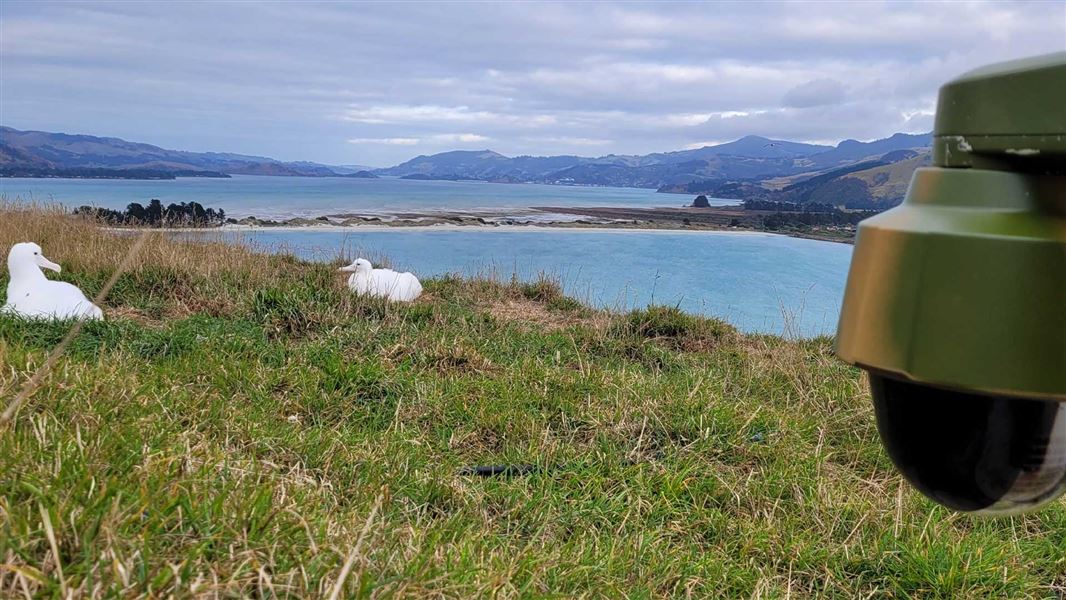DOC launched Royal Cam in 2016 and since then we’ve welcomed thousands of viewers. We’ve also partnered with the Cornell Lab of Ornithology, who improved Royal Cam's video stream with a new camera in 2019.
We work hard to make sure Royal Cam viewers can enjoy royal albatross 24/7 without disturbing them. To do this, we chose a camera that would be clear, unobtrusive and broadcast well even during gale force winds.
Keeping albatross comfortable
We want to make sure the royal albatross you see on Royal Cam feel comfortable around the camera. So, we chose a model that runs silently and we could position to capture them in their natural habitat while giving them space. While the birds may look close to the camera, it’s placed 6 m from the nest. This makes sure it does not disturb the birds, while offering an unrestricted view of the nest.
The adult birds have paid no attention to the camera’s presence so far. But when moving around the headland, chicks can become curious about it. Royal albatross chicks use their beaks to explore, so you might see a curious chick giving the camera a peck once they wander from the nest. So, we’ve made sure the camera is ‘chick-proof’ and safe for their exploration.
Using the right hardware
Our latest camera, supplied by the Cornell Lab of Ornithology in 2024, is an Axis P5676-LE PTZ replacing the Axis P5635-E MkII PTZ which was installed by Cornell in 2019.
The camera can be panned up to 360 degrees remotely and has night vision internally in the cam. The previous cam had an external IR light. Panning allows us to widen the camera scope and keep the chick in view as much as possible, even while wandering outside the nest. Currently, panning is controlled by designated camera operators.
Seeing at night
The ‘light’ is an infrared illuminator or IR light that turns on automatically when light conditions are low. It has a 120 degrees lens that the detection system uses to pick up thermal radiation in the infrared part of the electromagnetic spectrum. Heat emitted by the scene is detected and converted into electronic signals which is then processed to produce an image. The Axis P5676 uses Forensic WDR, Lightfinder 2.0, IR Illumination to ‘see’ at night and is invisible and harmless to people and birds under normal use.
The IR is 850 nm wavelength and is invisible and harmless to people and birds under normal use. As a further precaution the IR is mounted above the camera to ensure that albatross are not able to walk up and stare into it.
Under some conditions at night the IR light may switch on and off relatively frequently, while this is unsettling to view on the live stream it is not detected by the wildlife in the area.
Zooming
The zoom on this camera has better magnification than any of our previous cameras, so you can see even more of what’s happening in the nest. Camera operators can zoom in very close to reveal detailing in the feathers and zoom out wide enough to ensure we get the most of the activity from adult albatross in the area.
Stabilisation
The headland is also often exposed to gale force winds and rough weather. We use a camera that can record clear video footage, even when being shaken by the wind. So, you can watch the video stream even while there are winds of over 100 km per hour.
Placing the camera
Each year since 2016, we chose a nest close to the DOC rangers' office where we can manage the live stream of the video. We found that the length of the cable could impact the video quality broadcast from the camera. This mean that the longer the cable, the greater the chance of bad video quality. So we’ve taken care to select spots that will provide the best video quality for viewers.
To keep it steady, we mount the camera on a wooden post. We hold it in position using an umbrella stand, a concrete base and rocks so it can withstand the wind and weather.
Protecting the heritage of the headland
Royal Cam is set up on Pukekura/Taiaroa Head. This is an important site for Māori, who were the first people to occupy this area several hundred years ago.
Heritage New Zealand have listed the headland as a category one historic site. This means the ground must remain undisturbed. Every measure has been taken to ensure that Royal Cam doesn't disturb the birds or negatively affect the historic site where it’s been placed.
